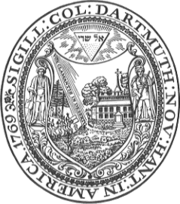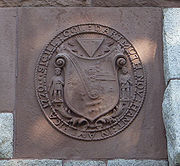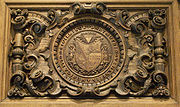
Seal of Dartmouth College
Encyclopedia

Dartmouth College
Dartmouth College is a private, Ivy League university in Hanover, New Hampshire, United States. The institution comprises a liberal arts college, Dartmouth Medical School, Thayer School of Engineering, and the Tuck School of Business, as well as 19 graduate programs in the arts and sciences...
, an Ivy League
Ivy League
The Ivy League is an athletic conference comprising eight private institutions of higher education in the Northeastern United States. The conference name is also commonly used to refer to those eight schools as a group...
university located in Hanover, New Hampshire
Hanover, New Hampshire
Hanover is a town along the Connecticut River in Grafton County, New Hampshire, United States. The population was 11,260 at the 2010 census. CNN and Money magazine rated Hanover the sixth best place to live in America in 2011, and the second best in 2007....
, United States. Anglo-American law generally requires a corporate body to seek official government sanction, usually in the form of a charter, in order to operate. Such chartered bodies normally authenticate their official acts by marking them with a distinctive seal
Seal (device)
A seal can be a figure impressed in wax, clay, or some other medium, or embossed on paper, with the purpose of authenticating a document ; but the term can also mean the device for making such impressions, being essentially a mould with the mirror image of the design carved in sunken- relief or...
. The seal's design is usually complicated to avoid counterfeiting, but it can also express something about the institution's history or mission. Dartmouth College is one such chartered body, and it obtained its official seal in 1773.
Design and creation
Dartmouth College received a royal charter on December 13, 1769 through New Hampshire's colonial governor John WentworthJohn Wentworth
John Wentworth may refer to:*John Wentworth , lieutenant governor of New Hampshire from 1717-1730*John Wentworth , jurist and revolutionary leader in New Hampshire...
. The charter required a seal that was to be:
Nevertheless, on March 13, 1770, founder Eleazar Wheelock
Eleazar Wheelock
Eleazar Wheelock was an American Congregational minister, orator, educator, and founder of Dartmouth College....
wrote to the trustees of the English fund that was supporting the College (rather than the American trustees of the institution itself, as the charter stipulated) to suggest that his:

Lebanon, Connecticut
Lebanon is a town in New London County, Connecticut, United States. The population was 6,907 at the 2000 census. The town lies just to the northwest of Norwich, north of New London, and east of Hartford...
. Wheelock then designed a seal for his college bearing a striking resemblance to the seal of the Society for the Propagation of the Gospel, a missionary society founded in London in 1701, in order to maintain the illusion that his college was more for mission work than for higher education. Wheelock arranged for Nathaniel Hurd, a Boston silversmith, to engrave the seal. Hurd had engraved many coats of arms and appears in a John Singleton Copley
John Singleton Copley
John Singleton Copley was an American painter, born presumably in Boston, Massachusetts, and a son of Richard and Mary Singleton Copley, both Irish. He is famous for his portrait paintings of important figures in colonial New England, depicting in particular middle-class subjects...
portrait of ca. 1765 with two books, one of which is A Display of Heraldry by John Guillim
John Guillim
John Guillim was an antiquarian and officer of arms at the College of Arms in London. He is, perhaps, best remembered for his monumental work A Display of Heraldry which was first published in London in 1610....
(1610). Wheelock wrote to Governor Wentworth on May 22, 1772, saying "I hope that Mr Hurd will have the College Seal compleated by Commencement." The seal (a single-sided "female" die used to form impressions in wax) was ready by Commencement of 1773, and Portsmouth resident and former Chief Justice and Treasurer of the Province of New Hampshire George Jaffrey donated it to the College. The trustees officially accepted the seal on August 25, 1773, describing it as:
History and revisions

Dartmouth University
Dartmouth University is a defunct institution in New Hampshire which existed from 1817 to 1819. It was the result of a thwarted attempt by the state legislature to make Dartmouth College, a private college, into a public university. The United States Supreme Court case that settled the matter,...
). The Dartmouth College Case named Woodward as the defendant and technically sought to recover the items that he had hidden. The College's success in the Supreme Court
Supreme Court of the United States
The Supreme Court of the United States is the highest court in the United States. It has ultimate appellate jurisdiction over all state and federal courts, and original jurisdiction over a small range of cases...
returned the seal to its possession and extinguished the University.
In 1876, the College switched from having its seal impress wax to having it impress paper. This required a second, "male" die to fit under the original. The seal design was also carved in sandstone on the exterior of Rollins Chapel in 1886 (see above) and in wood on the interior of Commons in the Collis Center in 1901 (see right).
On October 28, 1926, the trustees affirmed the charter's reservation of the seal for official corporate documents alone. The College Publications Committee under Ray Nash commissioned typographer W. A. Dwiggins to create a line-drawing version of the seal in 1940 that saw widespread use.
Dwiggins' design was modified during 1957 to change the date from "1770" to "1769," to accord with the date of the College Charter. The trustees commissioned a new set of dies with a date of "1769" to replace the old dies, now badly worn after almost two hundred years of use. The 1957 design continues to be used under trademark number 2305032.

